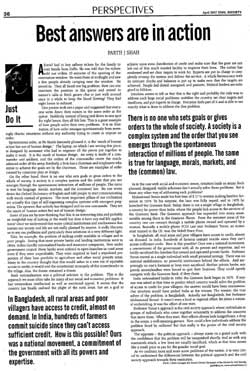Online Articles
It is in recognition of the merit of private schools that the Act says they must reserve seats for the poor. Why not give students a 100 per cent choice?
The Right to Free and Compulsory Education Act entrusts the government with the responsibility to ensure that every child gets quality education in India. Does this mean that every child has to go to a building called “government school”? Is the school’s ownership really critical to assuring education? Does it really matter to parents and children where they get quality education?
Our pedagogy should look beyond exams and help students fulfil their dreams. Since decades, the education policy India should follow has been a matter of debate. Aamir Khan’s “3 Idiots” has only intensified the discussion. In the movie, there is a flashback scene where the child protagonist attends classes of his choice. The child grows up to become a renowned scientist. The film questions the system of evaluation on the basis of examination in particular and the education system in general. In my view, this is a valid criticism. The so-called classroom model of education that we follow in our country is primitive.
The most powerful idea in the RTE Bill is the reservation of 25% of seats in private unaided schools across the country for the children of weaker sections and disadvantaged groups. The poor will be able to choose one of the recognized private schools and the government would pay for their education. This is basically the idea of the school voucher. Even though the government does not use this terminology, the 25% reservation has created a National School Voucher Program. And it would be the world’s largest school voucher program!
School voucher is the most powerful instrument to make government run schools accountable, say Parth J Shah and Baishali Bomjan
The Indian educational system is the second largest in the world in providing access and coverage and spends a whopping Rs.41,978 crore annually. This figure is impressive, but we are all too painfully aware that inefficiencies abound in this system. There is a huge gap between our aspirations and the achievements on the ground, which reflect poor accountability for the tax payers’ money.
Money is controlled by governments the world over. Parth J Shah argues that this need not be so
India’s ‘Education for All’ movement can be traced back to the World Conference on Education for All, held in Jomtien, Thailand in 1990, where delegates from 155 countries and representatives of 150 organisations pledged to provide basic education for all by the year 2000. Yes, the Education for All objective was to have been achieved eight years ago!
How much does the government spend in a government school per child per month in India? Surprisingly it’s a question that very few interested in improving educational opportunities in India ask—whether in India or outside. You can bet that no state education minister knows that number with necessary details. Nonetheless it’s the critical point to start any discussion on the goal of education for all.
Over the years, India has tried many approaches to improve the quality of school education. The lack of quality in state schools has created a two-tier system of school education. Those who can afford, go to private schools and those who cannot go to government ones. The children of the poor have no option but the poorly functioning state schools. This gross inequality of schooling opportunities is the result of our current approach to education.
Since its launch in 2001, SSA has infused substantial new resources into India’s elementary education. In a sense, even before the Fundamental Right to Education became part of the Constitution, SSA has been striving to fulfill that right of the children in the age group of 6-14. Last year the budget allocation for SSA was Rs 7,800 crore, this year it is Rs 11,000 crore. This is on the top of the massive spending on the universalisation of elementary education.
